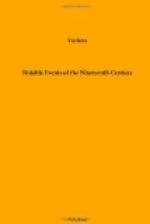It seems to have remained for Dr. T.J. Hussey, of Hayes, England, to suggest the actual discovery of the unknown planet by following the clew of the disturbance produced by its presence in a certain field of space. Dr. Hussey, in 1834, wrote to Sir George Biddell Airy, astronomer royal at Greenwich, suggesting that the perturbation of the orbit of Uranus might be used as the clew for the discovery of the planet beyond. But Sir George was one of those safe, conservative scholars who scorn to follow the suggestions of genius, preferring rather to explore only what is known already. He said in answer that he doubted if the irregularity in the Uranian orbit was in such a state of demonstration as to give any hope of the discovery of the disturbing cause. He doubted even that there was such irregularity in the Uranian orbit. He was of opinion that the observers had been mistaken in the alleged detection of perturbations. So the Greenwich observatory was not used on the line of exploration suggested by Hussey.
Three years afterward, and again in 1842, Sir George received letters from the younger Bouvart, again suggesting the possibility and probability of discovering the ultra-Uranian planet. These hints were strengthened by a letter from Bessel, of Koenigsberg. But Sir George B. Airy refused to be led in the direction of so great a possibility.
It was in 1844 that Professor James Challis, of the Cambridge observatory, appealed to Sir George for the privilege of using or examining the recorded observations made at Greenwich of the movements of Uranus, saying that he wished these tables for a young friend of his, Mr. John C. Adams, of Cambridge, who had but recently taken his degree in mathematics. Adams was at that date only twenty-five years of age. The royal astronomer granted the request, and for about a year Adams was engaged in making his calculations. These were completed, and in September of 1845, Challis informed Sir George Airy that according to the calculations of Adams the perturbations of Uranus were due to the influence of an unknown planet beyond.
The young mathematician indicated in his conclusions at what point in the heavens the ultra-Uranian world was then traveling, and where it might be found. But even these mathematical demonstrations did not suffice to influence Sir George in his opinions. He was an Englishman! He refused or neglected to take the necessary steps either to verify or to disprove the conclusions of Adams. He held in hand the mathematical computations of that genius from October of 1845 to June of the following year, when the astronomer Leverrier, of Paris, published to the world his own tables of computation, proving that the disturbances in the orbit of Uranus were due to the influence of a planet beyond, and indicating the place where it might be found. There was a close agreement between the point indicated by him and that already designated by Adams.




